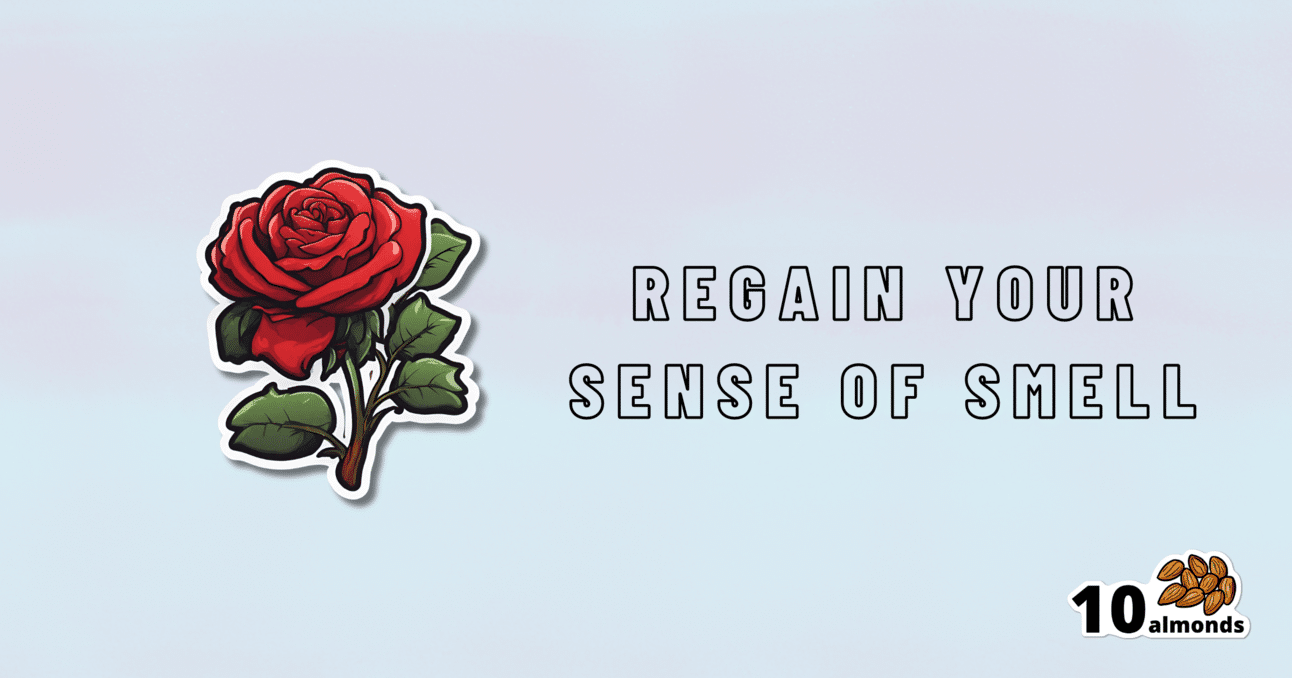Olfactory Training, Better
Loss of smell (anosmia) is associated with COVID and aging, but it could also be an early sign of neurodegenerative diseases like Alzheimer’s or Parkinson’s.

Anosmia, by any other name…
The loss of the sense of smell (anosmia) is these days well-associated with COVID and Long-COVID, but also can simply come with age:
National Institute of Aging | How Smell & Taste Change With Age
…although it can also be something else entirely:
❝Another possibility is a problem with part of the nervous system responsible for smell.
Some studies have suggested that loss of smell could be an early sign of a neurodegenerative disease, such as Alzheimer’s or Parkinson’s disease.
However, a recent study of 1,430 people (average age about 80) showed that 76% of people with anosmia had normal cognitive function at the study’s end.❞
Read more: Harvard Health | Is it normal to lose my sense of smell as I age?
We’d love to look at and cite the paper that they cite, but they didn’t actually provide a source. We did find some others, though:
❝Olfactory capacity declines with aging, but increasing evidence shows that smell dysfunction is one of the early signs of prodromal neurodegenerative diseases such as Alzheimer’s and Parkinson’s disease.
The loss of smell is considered a clinical sign of early-stage disease and a marker of the disease’s progression and cognitive impairment.❞
Read more: Neurons, Nose, and Neurodegenerative Diseases: Olfactory Function and Cognitive Impairment
What’s clear is the association; what’s not clear is whether one worsens the other, and what causal role each might play. However, the researchers conclude that both ways are possible, including when there is another, third, underlying potential causal factor:
❝Ongoing studies on COVID-19 anosmia could reveal new molecular aspects unexplored in olfactory impairments due to neurodegenerative diseases, shedding a light on the validity of smell test predictivity of cognitive dementia.
The neuroepithelium might become a new translational research target (Neurons, Nose, and Neurodegenerative diseases) to investigate alternative approaches for intranasal therapy and the treatment of brain disorders. ❞
~ Ibid.
Another study explored the possible mechanisms of action, and found…
❝Olfactory impairment was significantly associated with increased likelihoods of MCI, amnestic MCI, and non-amnestic MCI.
In the subsamples, anosmia was significantly associated with higher plasma total tau and NfL concentrations, smaller hippocampal and entorhinal cortex volumes, and greater WMH volume, and marginally with lower AD-signature cortical thickness.
These results suggest that cerebral neurodegenerative and microvascular lesions are common neuropathologies linking anosmia with MCI in older adults❞
- MCI = Mild Cognitive Impairment
- NfL = Neurofilament Light [Chain]
- WMH = White Matter Hyperintensity
- AD =Alzheimer’s Disease
Read more: Anosmia, mild cognitive impairment, and biomarkers of brain aging in older adults
How to act on this information
You may be wondering, “this is fascinating and maybe even a little bit frightening, but how is this Saturday’s Life Hacks?”
We wanted to set up the “why” before getting to the “how”, because with a big enough “why”, it’s much easier to find the motivation to act on the “how”.
Test yourself
Or more conveniently, you and a partner/friend/relative can test each other.
Simply do like a “blind taste testing”, but for smell. Ideally these will be a range of simple and complex odors, and commercially available smell test kits will provide these, if you don’t want to make do with random items from your kitchen.
If you’d like to use a clinical diagnostic tool, you can check out:
Clinical assessment of patients with smell and taste disorders
…and especially, this really handy diagnostic flowchart:
Algorithm of evaluation of a patient who has olfactory loss
Train yourself
“Olfactory training” has been the got-to for helping people to regain their sense of smell after losing it due to COVID.
In simple terms, this means simply trying to smell things that “should” have a distinctive odor, and gradually working up one’s repertoire of what one can smell.
You can get some great tips here:
AbScent | Useful Insights Into Smell Training
Hack your training
An extra trick was researched deeply in a recent study which found that multisensory integration helped a) initially regain the ability to smell things and b) maintain that ability later without the cross-sensory input.
What that means: you will more likely be able to smell lemon while viewing the color yellow, and most likely of all to be able to smell lemon while actually holding and looking at a slice of lemon. Having done this, you’re more likely to be able to smell (and distinguish) the odor of lemon later in a blind smell test.
In other words: with this method, you may be able to cut out many months of frustration of trying and failing to smell something, and skip straight to the “re-adding specific smells to my brain’s olfactory database” bit.
Read the study: Olfactory training: effects of multisensory integration, attention towards odors and physical activity
Or if you prefer, here’s a pop-science article based on that:
One in twenty people has no sense of smell—here’s how they might get it back
Take care!
Share This Post
Learn To Grow
Sign up for weekly gardening tips, product reviews and discounts.




